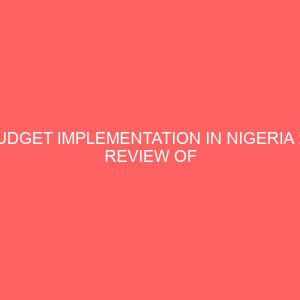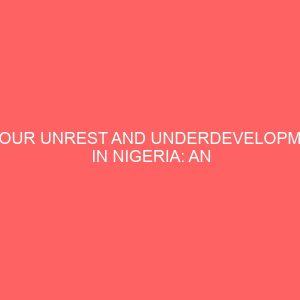Description
CHAPTER ONE INTRODUCTION 1.1 BACKGROUND OF STUDY Nigeria is among the few countries of the world characterized by contradictory socioeconomic and development scenarios (Nwokocha, 2007). Despite her enviable human and material resources, the country and its peoples are still classified among the very poor (Okunmadewa, 2001, HDI Report 2010) with no fewer than 54% of Nigerians living below poverty level (Akinyele, 2005). It is described as a country with a complex socio-political history that has for most part, impacted adversely on the population through worsening income distribution and increased poverty (Salamatu, 2008). Consequently, the number of rural inhabitants that migrate to cities with high hopes of overcoming powerlessness consistent with rural life is unprecedented. Microfinance has evolved as an economic development approach intended to benefit low income men and women, thus regarded as an effective tool for economic development (Siebel, 2003; Zahra, 2008; Ojo. 2009). An effective economic development programme is one in which the poor are the agents of change. The poor do not need aid, they need opportunity (Tessi, 2005) thus promoting economic growth, reduce poverty, support human development and improve the status of urban-rural communities. For the past 20 years, the government, international agencies and social organizations have been focusing on rural and women?s development Programmes (Rieneke, 2010; Shanti, 2008) one of the priorities of the Millennium Development Goal is poverty alleviation and economic development, women?s empowerment and gender mainstreaming. According to Kevin (2009) most of the poor people have little financial opportunity thus micro-finance could help poor people who have no collateral, but the willingness to work and to do some business activities from which they will acquire employment as well as income. Most Nigerian micro entrepreneurs are economically isolated, which means that their market is often local, small and does not offer any demand growth prospects. Commercial banks and other financial institutions normally do not like to go in that area because of the geographical constraints, underdeveloped infrastructure and other physical constraints. However, on the other hand, there is a substantial demand of micro credit. In this scenario, microfinance banks could obviously play an important role to mobilize local savings, extend credit as well as channelize borrowed fund/grant to the local rural people (Dhakal, et al, 2002). Micro finance is equally important to both men and women. Women?s experience of poverty is different and more acute than those of men because of gender-based forms of exclusion. Women become poor through deterioration in the household?s access to resources. Women?s are governed by more complex social constraints and responsibilities than men, and they are more concentrated in the non-monetized sector (United Nations, 2004; Shanti, 2008). In almost every African country, women comprise a large percentage of the poor (World Bank, 2002). The existence of the gender complexities in the handling of income affects the quality of family life, the quality of children?s nutrition and education, as well as household stability. Until women have access to economic opportunities, poverty cannot be reduced (Shanti, 2008) and economic development may not be sustained. 1.2 STATEMENT OF THE PROBLEM On balance, however, a school of thought argues that there is evidence that microfinance, does have a positive economic impact on economic development in terms of income growth and reduced vulnerability, although the effects are often small (Kevin, 2009) and all clients do not benefit equally. While the other school of thought states that microfinance banks have been shown to be interested in their own financial survival than embarking on poverty alleviation or economic development exercise (Davies et al,2006). Lack of access to income opportunities or skill-based training opportunities kept many people in Nigeria shackled to poverty. Unemployment is high, forcing many people to immigrate to other countries. Unless the poor people are brought into the mainstream for economic and social change, we will fail to bring change development (Aku et.al, 1997). Capital accumulation in modern world requires financial intermediation because economic and social issues are closely intertwined, one reinforcing the other (Njiforiti et.al, 2008). People?s access to credit is limited because both formal and informal credit institutions are inclined towards funding property owners (Shanti, 2008). All formal credit institutions seek tangible collateral for their loan and majority of the poor are disadvantaged from these credit since they have no access or limited collaterals. The money lenders are also interested in earning high interest or acquiring the debtor?s property rather than financing people in need (Siebel, 2003). In the case of some women, their access to institutional credit is further restricted by their confinement to household activities and lower level of awareness and educational attainment (World Bank, 2002). The World Bank recently confirmed that poverty is increasing in Nigeria and capital is one of its highest rank constraints (Human Development Index Report, 2010-2011) in economic development. Nigeria since her independence, various credit schemes have been put in place to alleviate poverty to bring about desired economic growth and development but they have failed to achieve these targets (Fidelis, 2009). In December 2005, the Central Bank of Nigeria (CBN) introduced a Microfinance Policy Framework to enhance the access of micro- entrepreneurs and low income households to financial services required to expand and modernize their operations in order to contribute to rapid economic growth and development. 1.3 RESEARCH QUESTIONS Arising from the above statement of problem are the following questions 1. What is the extent of synergy between Microfinance banks and economic growth in Nigeria? 2. What is the likely impact of microfinance banks on business in Nigeria? 3. Has Microfinance bank been able to contribute to the economic growth of the country? 4. What are the problems militating against the MFBs and Client in Nigeria? 5. What are the ways of solving the problems militating against Microfinance banks in the Country? 1.4 OBJECTIVES OF THE STUDY The main objective of the study is to evaluate the impact of microfinance banks in economic growth in Nigeria. The specific objectives are: 1. To evaluate the activities of Microfinance banks on economic growth in Nigeria. 2. To assess the impact of microfinance banks on the business of the beneficiaries in Nigeria 3. To check whether microfinance banks have been able to contribute to the economic growth of Nigeria. 4. To investigate the problem(s) militating against Microfinance banks in Nigeria 5. To proffer ways of solving the problems. 1.5 SIGNIFICANCE OF THE STUDY This study would help policy makers and the regulatory body examine whether or not there is need for modification in its policy framework. It would also provide data to all other institutions and individuals who intend to work within the group that fight against the existing poverty of the country. The study will provide recommendations to the International Agencies, NGO?s, Government and Human right activist. 1.6 Scope and the Limitations of the Study The study area of this research work is the Excel Microfinance bank, Sango Eruwa, Oyo State. 1.7 LIMITATION OF THE STUDY 1. Network interconnectivity to enhance elaborate research ? 2. High level of illiteracy 3. Organization operational huddles. 4. Time and cost constraints due to cause of scarcity in gasoline to go about the research. 1.8 ORGANIZATION OF THE STUDY This study consist of five chapters, the first chapter deals with the general introduction, statement of problems, research questions, objectives of the study, hypotheses and significance of study. The second chapter focuses on the conceptual framework, theoretical framework, Empirical Literature, Microfinance role in economic development, Microfinance policy and development framework and transmission mechanism. Chapter three discussed the study area, source and nature of data, data collection technique, and analytical framework. In Chapter four the result of the study findings is presented and analyzed. The final chapter discussed the finding, recommendation and conclusion of the research.







